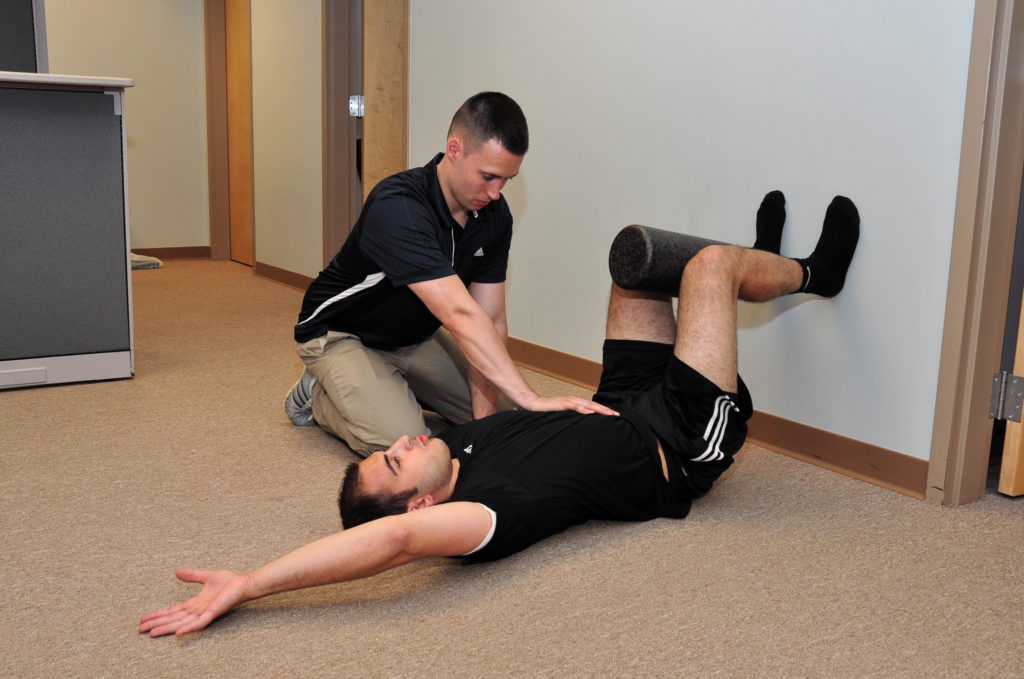
Written in conjunction with Strength Coach Podcast Ep. ###
In our last episode of Learn To Coach, Brendon Rearick discussed using internal and external cueing to communicate optimally with your clients. In this week’s segment we’re going to discuss how physical cueing and hands on coaching can make your life easier as a coach and help the athlete learn more efficiently.
Kinesthetic cueing is the use of physical cues and constraints to optimally position an athlete during exercise. This could include using an object like a dowel road to cue spinal alignment or using a 12 inch plyo box to set a standard squat depth or even the use of your hands to cue an athlete to pull their shoulders back.
Too often, coaches waste their breath providing verbal cues that their clients do not understand. So, why not save you and your client the frustration and instead use physically driven cues that set the client up for success.
Kinesthetic cueing creates “Self-Limiting” exercise, meaning it demands mindfulness and engagement with the task at hand. When you provide physical constraints to an exercise the client must work around them and as a result it well help them to execute the movement the way that you want.
The use of simple tools and some clever thinking can be the difference between a confused athlete and a masterful one. Rather than attempting to explain a posture to an athlete that has no context we should strive to provide kinesthetic cues that will provide tactile feedback to the athlete.
One cue we use frequently is the dowel rod on the spine to coach any movement where we wish to see static spinal alignment. While in prone, quadruped or when hinging a stick can be a very effective tool to maintain alignment between the head, thoracic spine and sacrum.We’ll often use this approach when coaching planks, push-ups, dumbbell rows and hip hinges.
Cueing like this fixes small, mindless mistakes and helps clients improve physical awareness. The goal in any training session is to create conditions that demand engagement and put the athlete in position to execute successfully.
A few other examples of kinesthetic cues we use frequently at MBSC are
All of these approaches can help improve exercise execution without the coaching having to say a word or the client having to interpret anything.
In addition to using physical props like the ones mentioned previously, one of the most effective kinesthetic cues that we can use as coaches is our own hands. Providing physical feedback via appropriate manual touch has long been seen as a valuable technique to effectively cue movement patterning.
At MBSC, we’re always asking our coaches to be more hands-on. Hands-on cueing provides the client proprioceptive feedback, guiding the developing movement like a set of training wheels. Studies have even shown that short interventions of tactile-kinesthetic stimulation are able to increase local motor activity and alertness.
If an athlete is struggling, ask if you can help them out by putting them into a better position with your hands. People learn best by doing and feeling, and by properly positioning an athlete while they are struggling with something like a plank, hang clean or dumbbell row we can improve the clients sensory-motor experience so they can better learn and master a movement.
ARE YOU CERTIFIED YET?
Our Certified Functional Strength Coach Level 1 Online Course is designed to provide you with the same experience you’d get attending our live Level 1 workshop. Complete with the same pre-workshop materials, our Online Course includes a ‘Virtual Live Workshop’, where you will follow a CFSC instructor through an entire Level 1 Workshop complete with instruction, demonstration and question and answer as if you were spending the day at Mike Boyle Strength and Conditioning. Keeping with our rigorous practical standards, all enrollees will be required to complete an online exam and a coaching practical featuring video and open ended questions to complete their certification.